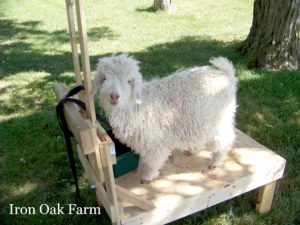 I would raise fiber goats whether I made money on them or not. I love our goats, and I love working with fiber in all its forms. It is incredibly interesting to me to work with a product from its very roots (the goat) to a finished usable product, (a pair of socks, sweaters, blanket etc.)
I would raise fiber goats whether I made money on them or not. I love our goats, and I love working with fiber in all its forms. It is incredibly interesting to me to work with a product from its very roots (the goat) to a finished usable product, (a pair of socks, sweaters, blanket etc.)
But the nice thing is that you can, in fact, make a profit from fiber animals. In particular, Angora goats. Goats are cost efficient in that they eat a similar amount to sheep and other fiber animals, but produce twice as much fiber.
In this post I’d like to:
- To show the cost breakdown of keeping 1 goat for a year
- Show what 1 goat can produce in a year
- Show the cost breakdown of the mill processing
- Compare these figures and show how a profit can be made
- I’d also like to talk about where and how to sell your fiber work
The Cost Keeping an Angora goat for 1 Year
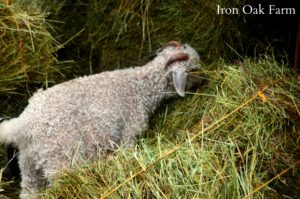 This chart shows roughly what is the cost to raise 1 goat for a year. These numbers can change depending on the area you live in, what the local stores charge for feed etc. We also hay our own field, so besides the cost of baling twine and tractor fuel, our hay is “free”.
This chart shows roughly what is the cost to raise 1 goat for a year. These numbers can change depending on the area you live in, what the local stores charge for feed etc. We also hay our own field, so besides the cost of baling twine and tractor fuel, our hay is “free”.
Your goat may eat more/less depending on your choice of diet, climate and how much pasture you can provide.
| Feed | Price Per Bag/Unit | Daily serving | Daily Cost | Yearly Cost |
| Sweet Feed | $5.99 /50lb | 4 cups | $.24 | $87.00 |
| Mineral | $12.99 /25lb | 2 Tbsp | $.03 | $12.00 |
| Hay | $4.00 /Bale | 1/8 bale | $.50 | $183.00 |
| Sun Oiler Seeds | $20.00 /40lb | ¼ cup | $.13 | $47.00 |
| Total | $.90 | $328.00 |
Hay, by far is the most expensive part of keeping a goat, that and the initial building/fencing costs if that’s not already a part of your homestead.
We hay our own field, so I can luckily subtract that cost from our total.
How Much does an Angora Goat Produce?
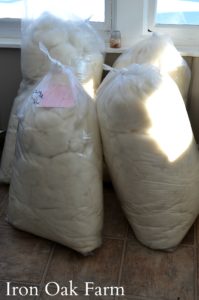 We always weigh our fiber in total after all the goats have been shorn, so coming up with this figure was a little difficult.
We always weigh our fiber in total after all the goats have been shorn, so coming up with this figure was a little difficult.
In 2016, we got 61 finished pounds of Mohair from 5 adult goats from both the spring and fall shearing. So that’s about 12 pounds per goat per year.
A Bit about Productivity
Kid mohair is considered the most luxurious of Mohair fiber. It also brings top dollar. Fiber can be considered “Kid” fiber for the first year to 2 years of the goat’s life. Some sellers like to be transparent and label their fiber “2nd-year kid Mohair” for later shearings.
In the same respect, as a goat ages, its fiber becomes less desirable. In later years, the fiber will become rough at the spine and some of the fibers become “kempt” which is more hair-like, hollow and brittle. These should be discarded from other more quality fibers.
Mill Costs
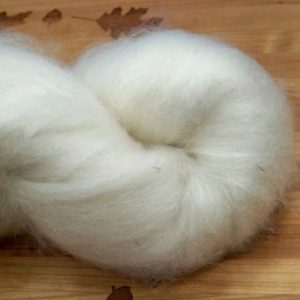 As I said in my last post, we take our fiber to the roving state at the mill. There are many options that you can do with your processing order. Logically, the more you have the mill do, the more money it costs.
As I said in my last post, we take our fiber to the roving state at the mill. There are many options that you can do with your processing order. Logically, the more you have the mill do, the more money it costs.
Mohair is also considered an exotic fiber, which costs a little more to be processed. However, it can also be sold at a higher rate.
$10.80 per pound to get to the roving state
In the off-season you get 15% off which takes the cost down to $9.18 per pound
We also pre-pay so that’s another 15% off the total.
So for 1 goat. 12 pounds of fiber x $9.18 = $110.16 x 15% prepay discount = $94
Total $93.64 for 12# mohair or 1-year shearing
Making a Profit
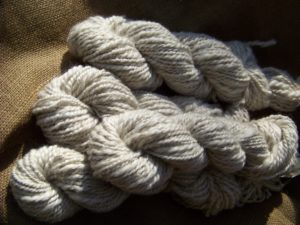 The more you do with your fiber, the higher you can charge. So if you dye your roving, spin it into yarn. Or dye the yarn etc., your price should reflect that.
The more you do with your fiber, the higher you can charge. So if you dye your roving, spin it into yarn. Or dye the yarn etc., your price should reflect that.
On our farm, without the cost of hay, to produce 12# of roving fiber from keeping a goat for a year, including feed costs and mill processing it costs:
Our cost: $239.00 = 12# roving
So around $20.00 per pound, $1.25 per oz.
I sell dyed, hand spun yarn for $6.00 per oz. I sell it in 4 oz skeins, $24 per skein.
I have always sold out of our mohair.
I make around $4.75 per oz of hand dyed, handspun yarn.
That’s $76 per pound
And $912 per goat.
At one point we kept 8 fiber goats, so for the year that was around $7300 from our herd.
Is it millions? No, but it’s a nice little side business that I enjoy, and coupled with other incomes on our farm, keep us afloat.
There are a lot of contributing factors that can change these numbers, vet visits, vaccines, what you choose for bedding etc. But hopefully, this equation can give you a rough idea of how money can be made with fiber goats.
Where and How to Sell
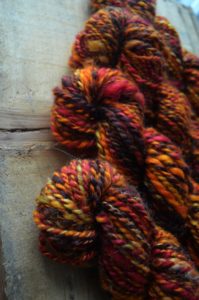 I sell, for the most part through our website and on Etsy.
I sell, for the most part through our website and on Etsy.
You can also join a fiber guild and participate in fiber shows
On top of fiber sales, I also teach spinning. A secondary resource that not only generates income but creates new, potential buyers, as they learn the new skill, they will be looking for a roving supplier.
Each farm is set up differently, and each circumstance may bring up different factors. Hay may be more or less expensive in your area, maybe you choose to forgo grain and feed alfalfa. Perhaps you might find it hard to get customers to pay x amount of dollars for handspun fiber.
But I truly feel that if there is an interest on your part, that there is enough wiggle room to make raising angora goats an enjoyable and profitable experience.











4 Comments
[…] what is the angora goat used for? This is not really a goat you would want to raise for milk or meat, although you could if you really wanted to (the hair really is the best part though). The wool you […]
What are names of places to send the fiber.
Hello 🙂 Thank you so much for this information. I have some other questions about Angora Goats: Do they co-habitat well with other types of goats, such as dairy goats? You mentioned that they don’t like rain, will they be okay in a humid environment even if they have an option of a shelter? I live in a rain forest.. Also, After they turn a few years old and they don’t produce quality wool, do you just keep them as pets for the duration of their life? Thank you,
Amber 🙂
Ha,
I have had nothing but expenses w/ my fiber goats. From what you listed to mites, Vet bills & medication trying to combat this new Intrusion on our livestock.
We couldn’t even use the fleeces the first and (best) year.
A steep learning curve when we thought we were doing things by the book.
They are sweet animals though.